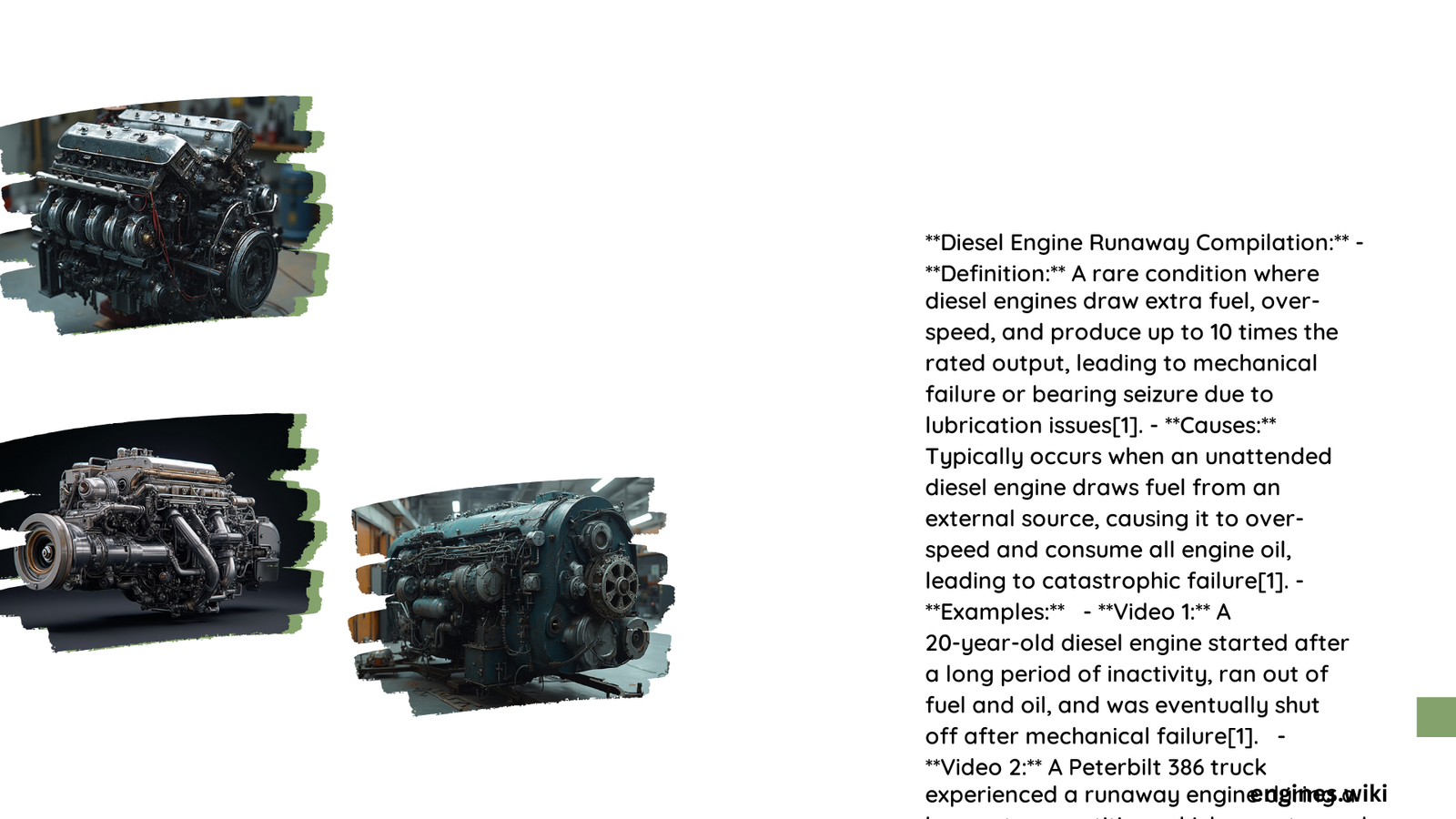Diesel engine runaway compilation is a critical safety concern in industries relying on diesel-powered equipment. This phenomenon occurs when a diesel engine ingests an uncontrolled source of fuel or combustible material, causing it to accelerate beyond its maximum designed speed. This compilation examines various incidents, causes, symptoms, and prevention strategies related to diesel engine runaway events, providing valuable insights for operators and safety professionals in high-risk environments.
What are the Most Notable Diesel Engine Runaway Incidents?
Diesel engine runaway incidents have occurred across various industries, often with devastating consequences. Here are some of the most significant cases:
- BLSR, Ltd. Rosharon, Texas (January 2003)
- Two vacuum trucks experienced runaway and explosion
- Cause: Hydrocarbon vapors drawn into idling engines
-
Result: 2 fatalities, 3 injuries
-
BP Texas City Refinery (March 2005)
- Idling diesel pickup truck ignited a vapor cloud
- Cause: Engine over-revved and backfired
-
Result: Fatal accident, significant refinery damage
-
Macondo Well, Gulf of Mexico (April 2010)
- BP Deepwater Horizon disaster
- Cause: Diesel engine overspeed in engine/generator room
-
Result: 11 fatalities, massive oil spill
-
Chevron Refinery, Richmond, CA (August 2012)
- Explosion with possible ignition from idling rig’s diesel engine
- Cause: Suspected hydrocarbon vapor ingestion
These incidents highlight the severe consequences of diesel engine runaway events and underscore the importance of proper safety measures and prevention strategies.
What Causes Diesel Engine Runaway?

Diesel engine runaway can occur due to various factors:
- Mechanical Failures
- Overfull crankcase
- Fuel dilution
-
Bypassed governor or throttle control
-
Fuel Contamination
- Ingestion of flammable vapors from the environment
-
Common in oil and gas production, refining, and petrochemical industries
-
Operator Errors
- Failure to follow safety policies
- Non-use of positive inlet air shutoffs
Understanding these causes is crucial for implementing effective prevention strategies and maintaining safe operating conditions.
How Can You Identify a Diesel Engine Runaway?
Recognizing the symptoms of a diesel engine runaway is critical for quick response and mitigation. Key indicators include:
- RPM Fluctuations
- Significant overspeeding
-
Engine running at increasingly higher RPMs
-
Abnormal Exhaust Emissions
- Unusual smoke or flame from the exhaust
-
Indicates burning of external fuel source
-
Unusual Engine Sounds
- Loud, abnormal noises
- Backfiring sounds
Quantitative data on these symptoms include:
- RPM Thresholds: Engines can reach 10 times their rated output (e.g., 15,000-25,000 RPM for engines typically operating at 1,500-2,500 RPM)
- Visible flames or excessive smoke from the exhaust
What are Effective Prevention Strategies for Diesel Engine Runaway?
Preventing diesel engine runaway involves a combination of regular maintenance, inspections, and equipment upgrades:
Maintenance Schedules
| Task | Frequency |
|---|---|
| Inspect crankcase ventilation system | Every 500-1,000 operating hours |
| Check closed crankcase filter systems | Monthly |
| Inspect air filters and turbo hoses | Weekly in high-risk environments |
Specific Inspection Techniques
- Check for fuel dilution in the crankcase
- Ensure proper crankcase oil level
- Inspect air intake system for contamination
Recommended Parts Replacements
- Install automatic diesel engine overspeed protection systems
- Cost: $1,000 to $5,000 per engine
- Use spark arrestors on all internal combustion engine exhausts within 100 ft of wellbores
What Safety Measures Should Be Implemented for Diesel Runaway Situations?
Effective safety measures are crucial for managing diesel runaway situations:
- Emergency Shutdown Procedures
- Block the air intake
-
Use a fire extinguisher rated for diesel engines
-
Specific Safety Equipment
- Emergency shutdown devices for combustion air supply
-
Spark arrestors on engine exhausts
-
Training Requirements for Operators
- Recognize runaway symptoms
- Understand dangers of approaching a runaway engine
- Know how to shut down effectively
Statistical Data on Effectiveness
- Automatic overspeed protection systems can reduce runaway risk by up to 90% in high-risk environments
- Proper training can reduce response times by up to 50%
By implementing these prevention strategies and safety measures, industries can significantly reduce the risk of diesel engine runaway incidents and their potentially catastrophic consequences.
